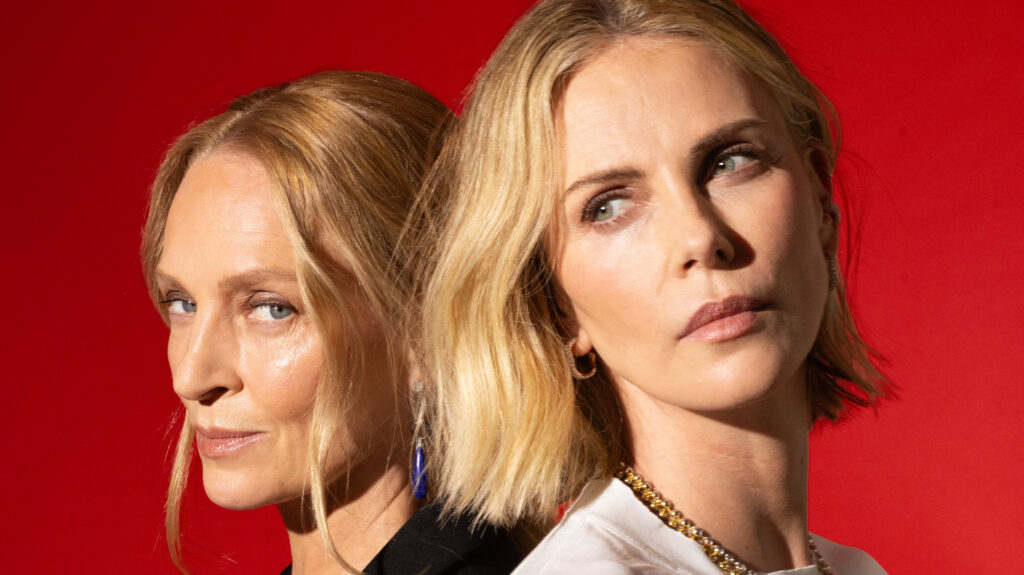Hollywood is often seen as a glamorous world of fame and fortune, but behind the scenes, actors frequently face significant physical and emotional challenges. Two iconic actresses, Charlize Theron and Uma Thurman, exemplify the stark realities of navigating the demanding world of film, each encountering unique struggles related to injuries and boundaries. This comprehensive blog explores Charlize Theron’s injuries sustained during her intense action roles, particularly her transformative work in films like Mad Max: Fury Road, and Uma Thurman’s courageous stance on personal boundaries and her experiences with on-set safety.

Part 1: Charlize Theron’s Injuries – The Price of Action Stardom
The Demands of Action Roles
Charlize Theron is renowned for her versatility, seamlessly transitioning between dramatic roles and high-octane action films. Known for her commitment to authenticity, Theron often performs her own stunts, which has led to several injuries over the years. Her rigorous training and willingness to push physical limits have earned her critical acclaim but also brought physical risks.
Key Injuries and Challenges
- Mad Max: Fury Road (2015): One of Theron’s most physically demanding roles, Mad Max: Fury Road required extensive stunt work and intense physical preparation. During filming, she endured multiple injuries, including muscle strains and bruises, sustained while performing stunts on rugged terrain and in high-speed car chases.
- Atomic Blonde (2017): For this spy thriller, Theron trained in various combat techniques, including judo and kickboxing. The intense fight scenes resulted in a number of injuries, such as sprained ligaments and bruised ribs. Theron has spoken openly about the toll the fight choreography took on her body.
- Other Roles: Even in non-action roles, the physicality required to portray complex characters has led to minor injuries and chronic pain. Theron’s dedication to her craft means she often pushes through discomfort to deliver compelling performances.
Coping and Recovery
Despite these challenges, Theron emphasizes the importance of proper physical conditioning, rest, and medical care. She has worked closely with trainers, physiotherapists, and medical professionals to manage injuries and prevent long-term damage. Her approach highlights the often overlooked physical toll of acting, especially in action genres.
Uma Thurman and Charlize Theron React to FINALLY Working Together in The Old Guard 2
The Broader Implication: Women in Action Films
Theron’s experiences shed light on the broader issue of safety and support for women in physically demanding roles. Her success has paved the way for more female-led action films, but it also raises important questions about ensuring actors’ well-being on set.
Part 2: Uma Thurman’s Boundaries – Speaking Out on Safety and Respect
Background: Uma Thurman’s Career and Challenges
Uma Thurman is a celebrated actress known for her iconic roles in films like Pulp Fiction and the Kill Bill series. Her work often involves intense physical scenes, but her experiences have also highlighted the critical issue of personal boundaries and safety on set.
The Harvey Weinstein Incident
In recent years, Thurman has publicly shared her harrowing experience with Harvey Weinstein, a powerful producer who allegedly pressured her into dangerous stunt work without adequate safety measures. This revelation brought attention to the pervasive culture of coercion and abuse in Hollywood.
- The Car Crash Scene in Kill Bill: Thurman recounted how she was pushed to perform a risky car stunt with minimal preparation, which resulted in a serious accident. The incident left her with physical injuries and emotional trauma. Her courage in speaking out has been instrumental in the #MeToo movement.
Setting Boundaries and Advocating for Change
Thurman’s advocacy extends beyond her personal story. She has become a vocal proponent of actors’ rights, emphasizing the importance of clear communication, consent, and safety protocols on set.
- Personal Boundaries: Thurman stresses that actors must feel empowered to say no to unsafe demands and that production teams have a responsibility to prioritize safety.
- Industry Reform: She advocates for systemic changes, including better stunt coordination, mental health support, and stricter enforcement of workplace safety standards.
Impact on Hollywood Culture
Uma Thurman’s openness has inspired many in the industry to reevaluate power dynamics and working conditions. Her story is a catalyst for ongoing discussions about respect, equity, and the human cost behind cinematic magic.
Part 3: Comparative Analysis – Injuries vs. Boundaries
Physical vs. Emotional Safety
While Charlize Theron’s narrative focuses on the physical injuries sustained during demanding roles, Uma Thurman’s experience highlights emotional and psychological boundaries. Both aspects are crucial for understanding the full spectrum of challenges actors face.
The Role of Empowerment
- Theron: Demonstrates empowerment through physical preparedness and resilience.
- Thurman: Illustrates empowerment through speaking out and advocating for safer working environments.
Lessons for the Industry
Together, their stories underscore the need for comprehensive safety protocols that address both physical and emotional well-being. This includes:
- Enhanced stunt safety measures
- Clear communication about role demands
- Support systems for actors facing pressure or abuse
- Cultural shifts toward respect and consent
Part 4: Frequently Asked Questions (Q&A)
Q1: What are some of the most common injuries actors sustain during action films?
Actors often experience muscle strains, bruises, sprains, fractures, and chronic pain due to stunt work and fight choreography. The risk increases when actors perform their own stunts without adequate training or safety measures.
Q2: How does Charlize Theron prepare for her physically demanding roles?
Theron undergoes rigorous physical training, including strength conditioning, combat training, and stunt rehearsals. She works with professional trainers and physiotherapists to prepare her body and recover from injuries.
Q3: What happened to Uma Thurman during the Kill Bill car stunt?
Uma Thurman was pressured to perform a dangerous car stunt with minimal preparation, leading to a serious crash. She sustained injuries and has spoken about the lack of safety measures and coercive environment on set.
Q4: How has Uma Thurman’s experience influenced Hollywood’s approach to on-set safety?
Her revelations have increased awareness about the importance of consent and safety, encouraging studios and production companies to implement stricter safety protocols and respect actors’ boundaries.
Q5: Are female actors at greater risk of injury or boundary violations on set?
Female actors in action roles may face unique risks due to physical demands and historical power imbalances in the industry. However, safety concerns and boundary violations can affect all actors regardless of gender.
Q6: What can productions do to ensure actor safety?
Productions should provide thorough stunt training, employ professional stunt coordinators, enforce safety protocols, cultivate respectful communication, and provide mental health support.
Q7: How do actors balance the desire for authenticity with safety?
Actors and directors must collaborate to find a balance between authentic performances and safety, often using stunt doubles, CGI, and carefully choreographed sequences to reduce risk.
Q8: Has Charlize Theron ever spoken publicly about her injuries?
Yes, Theron has openly discussed the physical toll of her roles in interviews, emphasizing the importance of preparation and recovery in managing injuries.
Q9: What lessons can aspiring actors learn from Theron and Thurman?
Aspiring actors should prioritize physical fitness, safety awareness, and personal boundaries. They should also feel empowered to speak up about unsafe conditions.
Q10: How has the #MeToo movement impacted discussions about boundaries in Hollywood?
The #MeToo movement has brought widespread attention to abuses of power, leading to greater advocacy for safe work environments, accountability, and respect for personal boundaries.
Conclusion
Charlize Theron and Uma Thurman’s experiences offer invaluable insights into the physical and emotional challenges actors face in Hollywood. Theron’s injuries highlight the demanding nature of action roles and the importance of physical preparedness, while Thurman’s story underscores the critical need for respect, safety, and empowerment on set. Together, their narratives inspire ongoing efforts toward a safer, more respectful, and equitable film industry.
By understanding and addressing these challenges, Hollywood can continue to produce compelling stories without compromising the well-being of the talented individuals who bring them to life.

